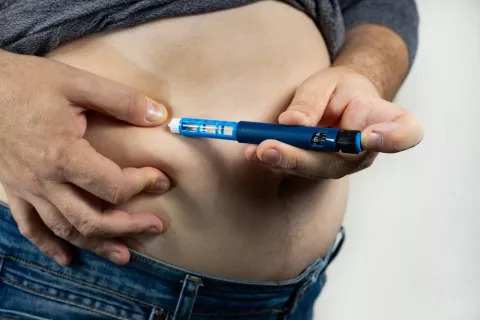Scientists continue to look for options to alleviate one of the fastest growing pandemics in the world: obesity. To do this, investigations are often opened with drugs already approved for other pathologies. This is the case of a new study carried out by the Northwestern University School of Medicine (USA) that has tested for this purpose the effect of prednisone, a corticosteroid drug frequently used to treat persistent asthma, reactions severe allergies, or rheumatic diseases such as arthritis, among others. Pfor that they administered prednisone once a week arobese males who were fed a high-fat diet. The result is that these mice they improved exercise endurance, became stronger, increased their lean body mass, and lost weight. Their conclusions have been published in The Journal of Experimental Medicine .
Prednisone once a week promoted nutrient absorption in the muscles, and the mice also increased muscle metabolism. The researchers also found that these mice had elevated levels of adiponectin, a fat-derived hormone that appears to play an important role in protecting against diabetes and insulin resistance.
The scientists also showed that mice that were already obese from eating a high-fat diet also benefited after prednisone once a week, experiencing increased strength, running ability, and lower blood glucose. “These studies were done in mice. However, if these same pathways hold true in humans, then once-weekly prednisone could benefit obesity,” said lead author Elizabeth McNally, MD, PhD, the Elizabeth J. Ward Professor of Genetic Medicine and director of the Center for Genetic Medicine. Genetics of this university.
The idea that prednisone once a week could promote nutrient uptake in muscle could be an approach to treating obesity
“Daily prednisone is known to promote obesity and even metabolic syndrome, a disorder in which elevated blood sugar and lipid levels and weight gain are implicated,” McNally said. “So these results, where we intermittently ‘pulse’ the animals with prednisone once a week, are surprisingly different. Obesity is a major problem, and the idea that prednisone once a week could promote nutrient uptake in muscle could be an approach to treating obesity.”
In search of the correct dose to work in humans
Most of what we know about steroids like prednisone comes from studies looking at what happens when prednisone, a glucocorticoid steroid, is taken every day. “We see a very different result when it’s taken once a week,” McNally said. “We need to adjust the dose to determine the correct amount for this to work in humans, but knowing that adiponectin could be a marker could provide a clue to what the correct human dose is.”
McNally described the weekly dose as “a bolus, or spike, of nutrients going into the muscle.” “We think there is something special about promoting this nutrient spike in muscle intermittently, and that it may be an efficient way to improve lean body mass,” he added. “What excites me about this paper is the finding that a simple change in dosing frequency can transform glucocorticoid drugs from obesity inducers to obesity preventers,” said another of the paper’s authors, Mattia Quattrocelli. “Chronic intake of these drugs once a day is known to promote obesity. Here we show that dosing the same type of drug intermittently, in this case once a week, reverses this effect, promotes muscle metabolism and energy expenditure, and reduces metabolic stress induced by a high-fat diet.” .
Can weekly dosing benefit patients with immune diseases?
Many patients take prednisone daily for various immune conditions. Known side effects of daily prednisone include weight gain and even muscle atrophy with weakness. The researchers want to determine if patients can get the same immune benefit from intermittent dosing of prednisone, which might be much more beneficial to muscle.
In previously published research, McNally’s team found that giving prednisone intermittently was helpful for muscular dystrophy, showing that prednisone once a week improved strength. The group also recently reported findings from a pilot trial in humans with muscular dystrophy in which a weekly dose of prednisone improved lean mass.
The truth is that there is no single dose for all cases of prednisone, since people have different responses to prednisone dosage. McNally wants to determine which biomarkers are most critical in signaling a beneficial response to prednisone. “If we can figure out how to choose the right dose of prednisone that minimizes atrophy factors and maximizes positive markers like adiponectin, then we can really personalize prednisone dosing,” he said.
The group also recently showed that weekly prednisone uses strikingly different molecular pathways to build muscle in male and female mice, according to a new study just published in the Journal of Clinical Investigation by Isabella Salamone, a graduate student in McNally’s lab.
The Circadian Connection of Weekly Prednisone
The benefits of weekly prednisone are related to circadian rhythms, according to another new study from Northwestern and the University of Cincinnati published last month in Science Advances. Cortisol and human steroid levels rise early in the morning before you wake up. “If you don’t give the drug at the right time of day, you don’t get the response,” Quattrocelli said. “In mice, we got good effects of intermittent prednisone on muscle mass and function when we dosed it earlier in the day. Mice have an inverted circadian rhythm as they generally sleep during the day and are active at night. This could mean that the optimal dosing time for humans during the day could be in the late afternoon or early evening, but this needs to be properly tested.”
The question thus seems clear: Do stronger and thinner mice equal stronger and thinner humans? The main caveat about this hopeful obesity benefit is that these studies have only been done in mice. McNally recalls that “while the pilot study in humans with muscular dystrophy is encouraging, mice muscles have more fast-twitch fibers than humans, and slow-twitch muscles may be different,” McNally said. Therefore, “further studies are needed to try to better understand whether these same mechanisms work in human muscles.”
.









